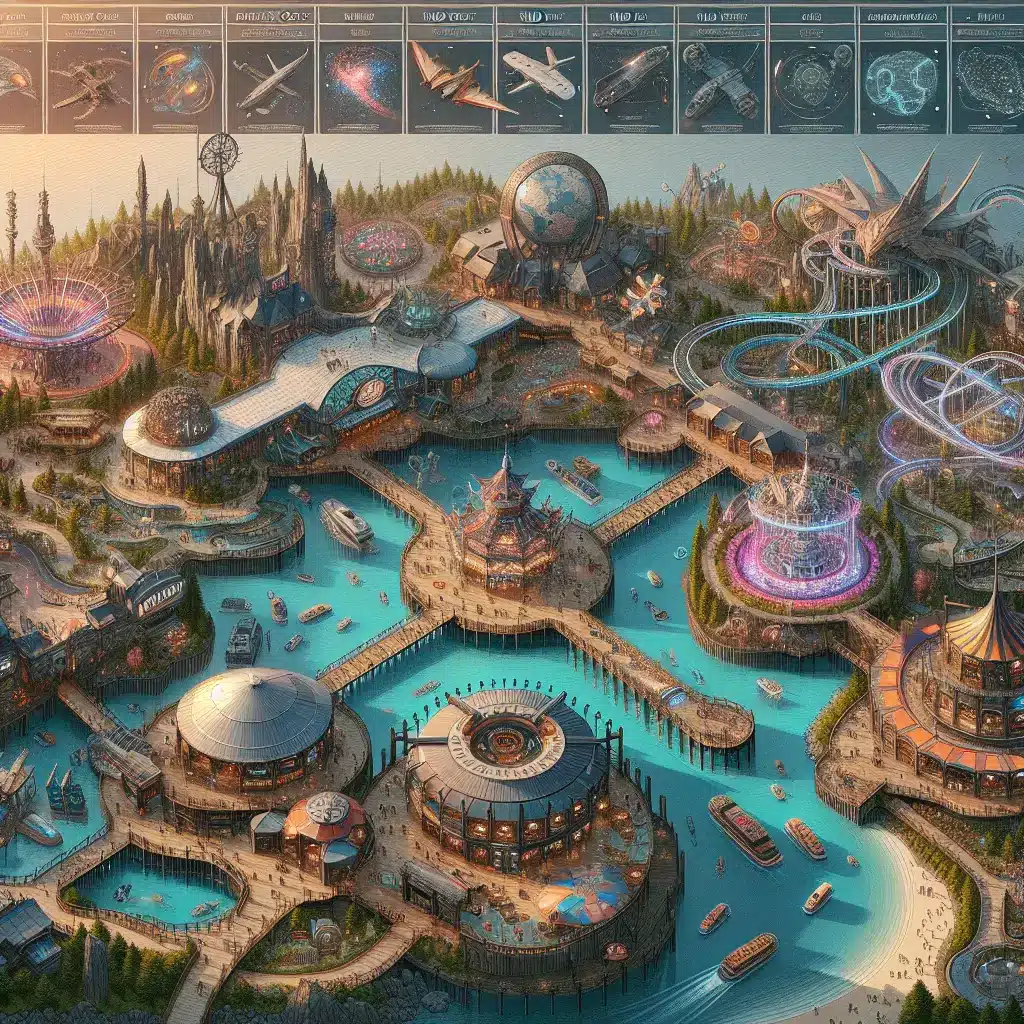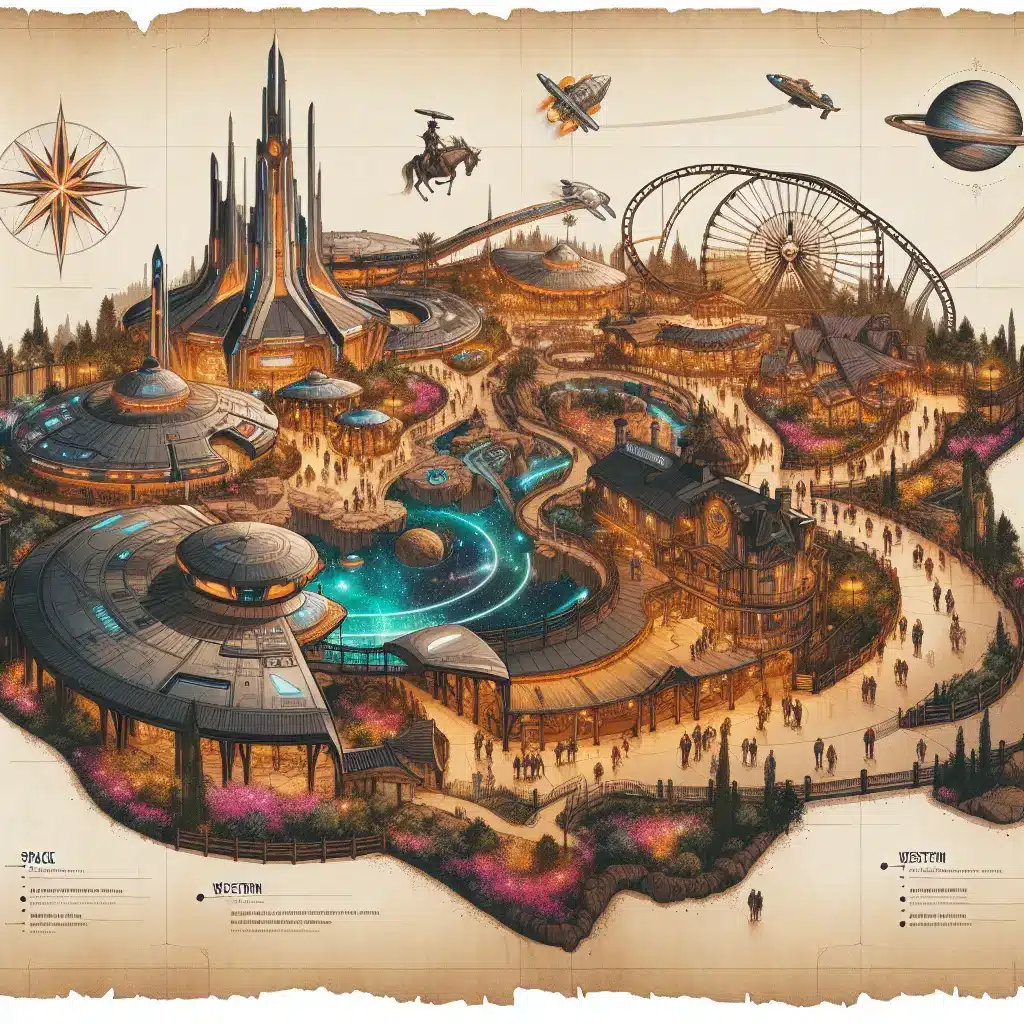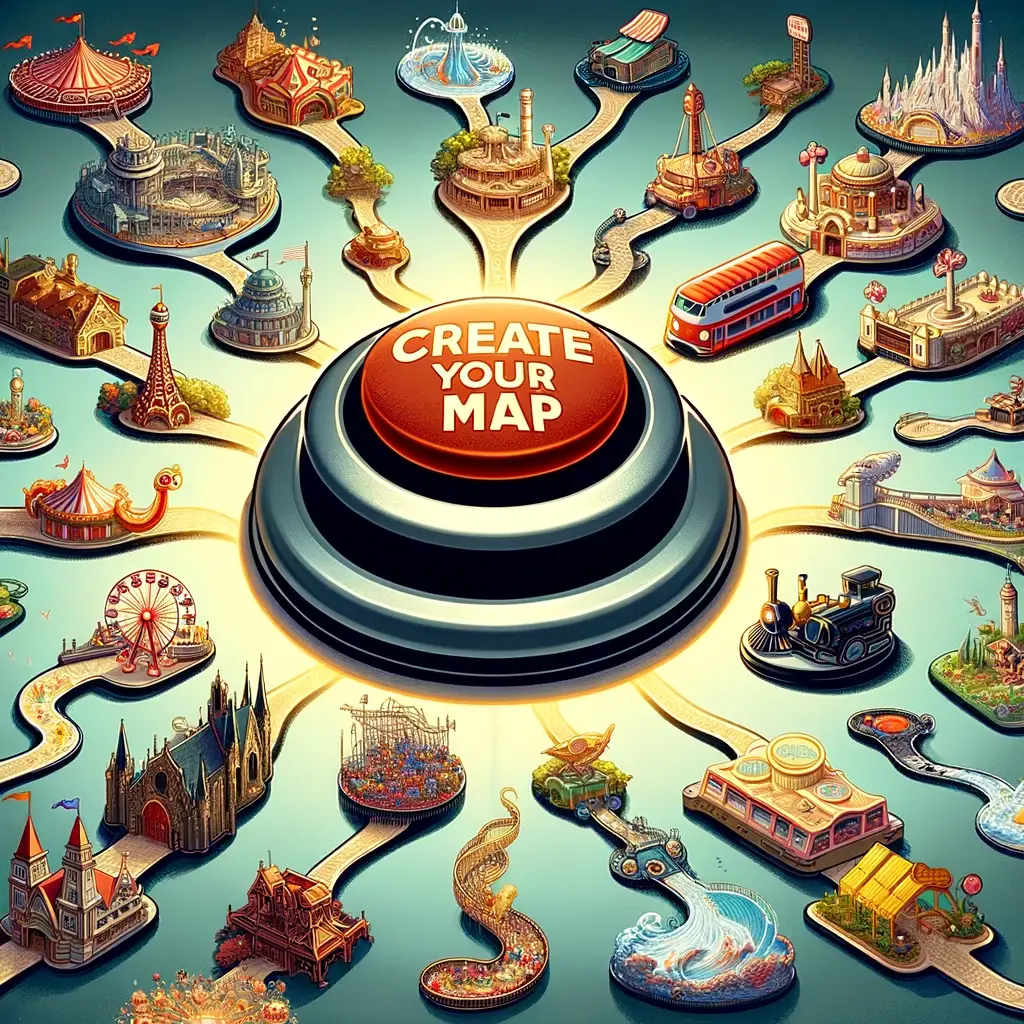Theme Park Map Maker: Build a Theme Park That Thrillseekers Will Wait in Line For
Craft your theme park map with precision and creativity. This theme park map maker specializes in converting your concepts into detailed, functional, and visually appealing maps.
From rides to themed zones, each element is tailored to your specifications. Just share your ideas, and our AI theme park map generator perfectly captures your vision. Remember: the only limitation is your your imagination!
Without further ado, design your own theme park online for free!
Try the Theme Park Map Generator
As you can see, the theme park creator online interface is intuitive, inviting users of all skill levels to participate in the creative process of amusement park map-making!
Theme Park Map Maker Examples
In the examples that follow, each map unfolds a story, showcasing the precise organization, thematic depth, and innovative design our tool offers.
You’ll see zones that combine fantasy and reality, where detailed castles stand tall near futuristic domes, and tranquil island retreats exist alongside thrilling dinosaur lands.
The strategic placement of rides and amenities demonstrates the tool’s ability to marry form with function, creating maps that are as navigable as they are captivating.
These samples are a glimpse into how your unique ideas can materialize into a park that promises memorable journeys for every visitor. Now, take a closer look at what could be the blueprint of your theme park dream!
Map Example 1

This example map from our tool illustrates a well-organized theme park layout with distinct zones. Central to the design is a striking structure, surrounded by themed areas:
- A fantasy-inspired section with castle-like buildings.
- A zone with futuristic elements featuring spherical and streamlined shapes.
- And a serene area resembling an island retreat with water features.
The map details an array of rides, from classic Ferris wheels to innovative coaster designs, each placed to balance the park’s flow.
Amenities are strategically positioned for ease of access, and pathways are clearly delineated for simple navigation.
This example showcases the tool’s capability to create a detailed, coherent, and visually appealing theme park map based on your input.
Hint: Not just for thrill rides this tool is also an adept festival map maker, perfect for organizing large-scale event spaces.
Map Example 2

This example map showcases a multi-themed park divided into four distinct areas. On the left, the ‘Mystic Forest’ features an intricate landscape with towering trees and whimsical structures, evoking a sense of enchantment. Adjacent to this is the ‘Pirate’s Flight’, where a classic pirate ship is moored in crystal blue waters, hinting at swashbuckling adventures.
Next, ‘Pirate’s Land’ presents a blend of the mystical and the nautical, with architecture that borrows from historic pirate lore, set amidst a network of waterways. Finally, ‘Dinosaur’s Land’ transitions into a prehistoric setting with towering dinosaur figures and a futuristic skyline, suggesting thrilling escapades among ancient creatures.
The map is rendered with attention to detail, capturing the essence of each theme through its distinct landscapes and attractions. Carefully planning each zone allows for an immersive guest experience where the adventure is both visible and tangible. This visual illustrates the diversity and detail that can be achieved when designing a park with our map-making tool.
Map Example 3

This map exemplifies the fusion of futuristic space themes with the rustic charm of a traditional Western park. At the center stands a towering, spire-like structure, a beacon of science fiction, surrounded by saucer-shaped buildings with gleaming metallic surfaces. The park is dotted with attractions that blend these two worlds; roller coasters loop around rocketship monuments, and a Ferris wheel with a design reminiscent of satellite arrays offers panoramic views of the park.
Pathways wind through the park, leading visitors past gardens with vibrant, otherworldly flora. The map features a seamless integration of space-age technology and Western aesthetics, evident in the architecture that marries Victorian influences with sleek, futuristic details. Visitors can expect interactive experiences that might include holographic displays or encounters with characters that bridge the Wild West with interstellar travelers.
The design showcases how the tool can interpret a unique theme, transforming traditional expectations of a theme park into an immersive experience that caters to both adventure enthusiasts and dreamers of the final frontier. This is the level of imaginative detail and thematic blending you can expect when you use our map-making tool to bring your vision to life.
Stuck? Here’s How to Design a Theme Park That Thrillseekers Will Wait in Line For
Designing a theme park map that captures the imagination of thrillseekers requires a blend of creativity, strategy, and attention to detail. Our “how to build a theme park” tool transforms your vision into a navigable, eye-catching map that excites and attracts visitors.
Here are some tips to ensure your design stands out:
- Define Your Themes: Start with broad themes for different zones of your park. Whether it’s fantasy, adventure, sci-fi, or horror, a strong theme is the foundation of your design, providing a cohesive experience. Example Prompt: “I envision a park divided into four main zones: ‘Pirate’s Cove’ with vintage nautical charm, ‘Future World’ with sleek, sci-fi aesthetics, ‘Wild West’ for a rugged adventure feel, and ‘Enchanted Forest’ full of whimsy and magic.”
- Highlight Signature Attractions: Identify key attractions or rides to serve as the main draws. Place them strategically throughout the park to ensure even crowd distribution and seamless flow. Example Prompt: “The centerpiece is ‘Dragon’s Flight,’ a high-speed coaster weaving through a dense, enchanted forest, and ‘Galactic Battle,’ a 4D interactive ride in ‘Future World.'”
- Incorporate Variety: Ensure a mix of rides, attractions, and amenities to cater to all ages and thrill levels. Include high-adrenaline rides, interactive attractions, family-friendly areas, and quiet zones for relaxation. Example Prompt: “Include a mix of thrill rides, family-friendly attractions like a carousel in ‘Enchanted Forest,’ interactive play areas in ‘Wild West,’ and tranquil spaces like a lagoon in ‘Pirate’s Cove’ for relaxation.”
- Think About Logistics: Accessibility and ease of navigation are crucial. Paths should be wide and clear, with plenty of signage. Consider the placement of restrooms, food stalls, and rest areas for visitor comfort. Example Prompt: “Design wide, accessible pathways connecting all zones, with clear signage. Position restrooms and food stalls at strategic intervals for convenience.”
- Use Visuals Wisely: When providing input or uploading documents, include images that inspire you. This could be color schemes, architectural styles, or specific ride designs. Our tool uses these visuals to understand better and execute your vision. Example Prompt: “For ‘Future World,’ I’m inspired by sleek, metallic structures and neon lights. Here are some concept art images that capture the vibe I’m aiming for.”
- Feedback Loop: Utilize the preview feature to review the map’s progress. Don’t hesitate to make adjustments or add details. The goal is to refine the map until it aligns perfectly with your vision. Example Prompt: “After reviewing the initial draft, can we adjust the location of ‘Dragon’s Flight’ to ensure it’s visible from the park entrance? This could enhance its allure.”
- Engage with the Community: Share your initial designs with potential visitors or a theme park enthusiast community. Their feedback can provide valuable insights and ideas you might not have considered.
Following these tips will start your design process with an easy-to-use amusement park map template, ensuring you cover all the essentials of a successful layout.
Remember, the key to a successful theme park map is not just in capturing the excitement of potential attractions but in creating a space where every visitor can find something that thrills them. With our tool, you can bring that space to life, ensuring your theme park is the next big destination for thrillseekers everywhere.
By crafting your prompts to be clear and detailed, you guide the design process effectively, ensuring each element of your theme park map aligns with your vision. The goal is to create a map that meets your expectations and inspires excitement and anticipation among potential visitors.
With thoughtful planning and creative input, your theme park design will become a destination that thrillseekers can’t wait to explore.

